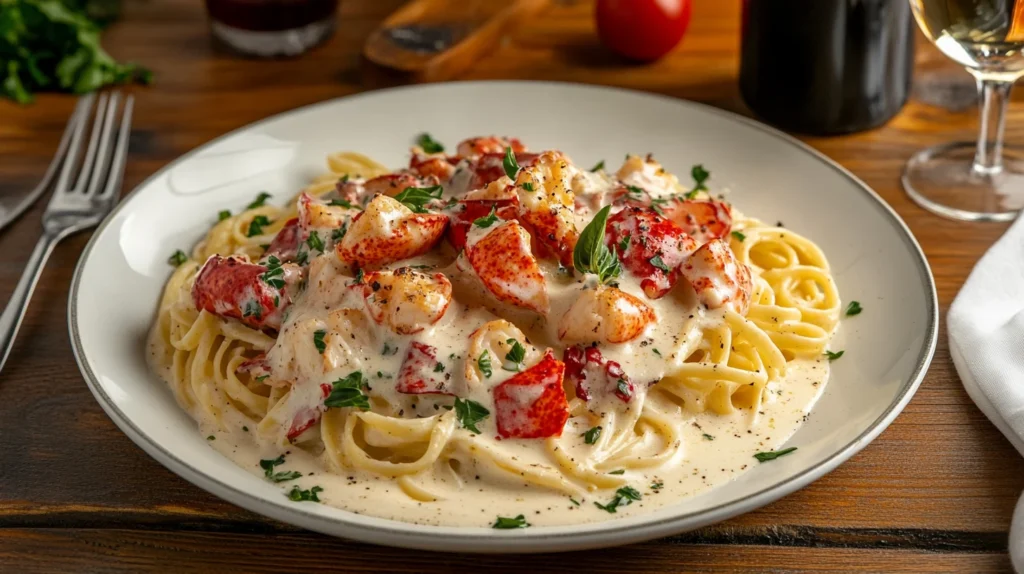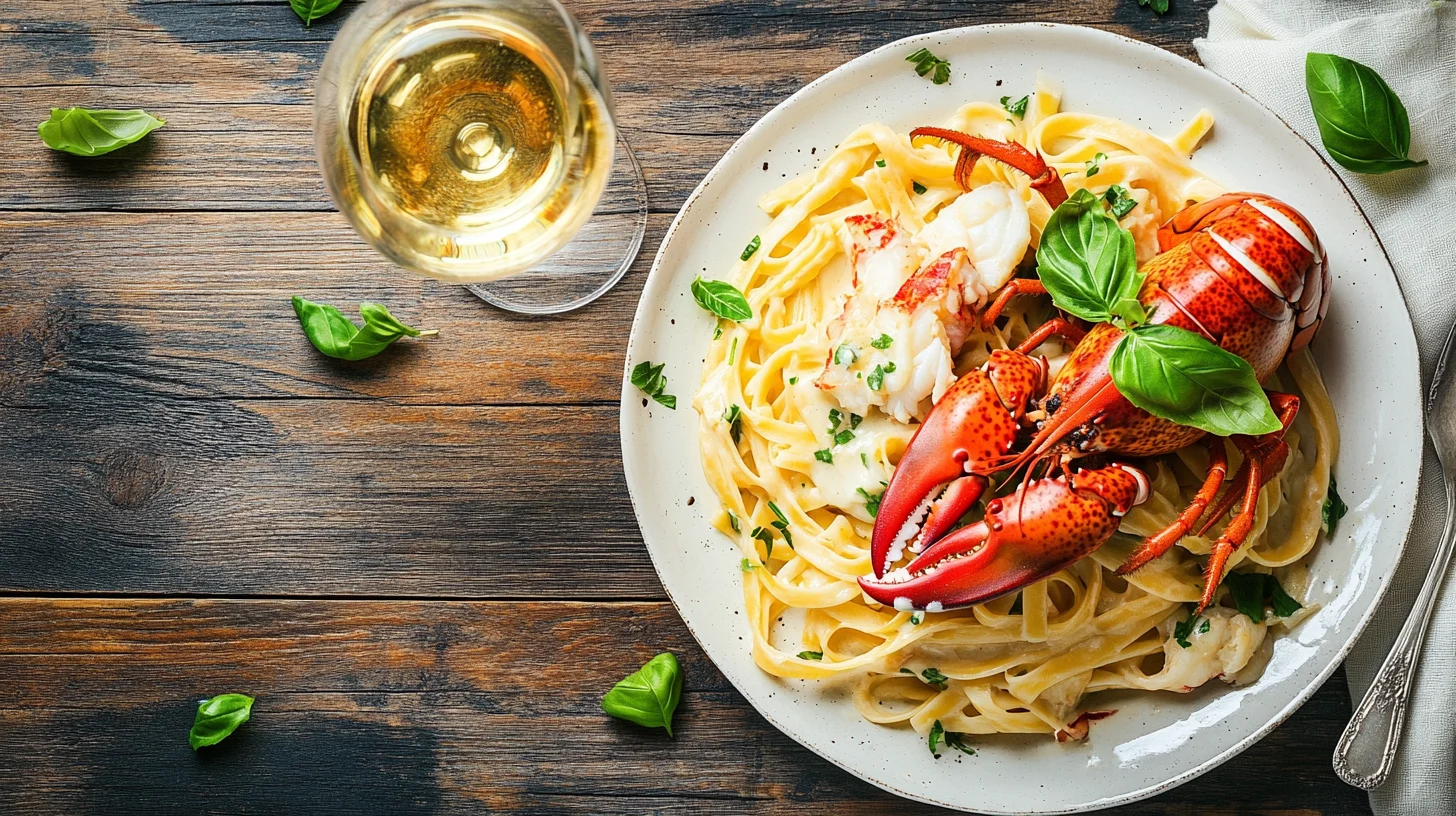Last updated on May 10th, 2025
Lobster Pasta Recipe: Elevate Your Culinary Skills
Introduction
Lobster pasta is the ultimate indulgence, blending tender lobster meat with creamy, flavorful pasta to create a dish that’s both elegant and comforting. Whether you’re hosting a special dinner party, celebrating a romantic evening, or simply treating yourself to something extraordinary, this recipe delivers gourmet quality with surprising ease. While cooking with lobster might feel intimidating, this guide simplifies every step, ensuring you can confidently prepare a meal that looks and tastes like it came from a high-end restaurant.
Pair your lobster pasta with complementary sides, a crisp glass of white wine, and the perfect ambiance for a dining experience your guests won’t forget. This dish isn’t just about indulgence—it’s about celebrating the joy of cooking and sharing something special. For more creative seafood dishes, try the Crab Brûlée Recipe for a luxurious appetizer that pairs beautifully with lobster pasta.
Table of contents
Why Make Lobster Pasta?
Lobster pasta combines the best of both worlds: the delicate sweetness of lobster and the creamy richness of pasta. Its versatility makes it suitable for various occasions, from intimate dinners to celebratory feasts. The lobster elevates this dish beyond standard pasta recipes, transforming it into a culinary masterpiece that’s surprisingly accessible.
Beyond its impressive presentation, lobster is a powerhouse of nutrients. Packed with omega-3 fatty acids and high-quality protein, it supports heart health, brain function, and overall wellness. This makes lobster pasta a dish that’s indulgent yet nutritious—perfect for those who appreciate both flavor and health benefits.
For inspiration on balancing rich dishes with lighter sides, check out The Ultimate Guide to Low-Carb Food. Pair your lobster pasta with fresh salads or roasted vegetables for a harmonious meal.
Ingredients for Lobster Pasta
This recipe uses a thoughtful selection of ingredients to ensure every bite is bursting with flavor.
For the Lobster
- 2 live lobsters or lobster tails: Fresh lobster provides the best flavor, but high-quality frozen lobster tails are a convenient alternative.
- Salt: Essential for perfectly seasoned boiling water, enhancing the lobster’s natural sweetness.
For the Sauce
- 2 tbsp olive oil: A flavorful base that complements the richness of the sauce.
- 1 medium onion, finely chopped: Adds sweetness and depth to the sauce.
- 2 garlic cloves, minced: Infuses the sauce with aromatic flavor.
- 3 tbsp tomato paste: Provides a concentrated, tangy foundation for the sauce.
- 1 cup heavy cream: Creates a luxurious, velvety texture.
- 1 cup lobster stock (made from the lobster shells): Adds a depth of flavor that ties the dish together.
Optional Additions
- Red pepper flakes: Add a subtle heat for those who enjoy a spicy kick.
- Fresh herbs such as basil or parsley: Garnish for freshness and visual appeal, enhancing the dish’s flavor.
Step-by-Step Instructions for Lobster Pasta
This guide simplifies the process of creating a gourmet lobster pasta dish, ensuring every component is rich, flavorful, and perfectly cooked.

1. Cook the Lobster
Prepare the Water:
Fill a large pot with water and generously season it with salt. The water should taste like the sea, as this enhances the lobster’s natural flavor.
Boil the Lobster:
- Once the water reaches a rolling boil, carefully add the live lobsters or lobster tails.
- Boil for 8–10 minutes (for a 1.25 lb lobster) or until the shells turn bright red. Larger lobsters may require an additional 1–2 minutes.
Cool and Remove the Meat:
- Transfer the lobsters to an ice bath to stop the cooking process and make them easier to handle.
- Using kitchen shears or a lobster cracker, carefully remove the meat from the tail, claws, and knuckles.
- Cut the meat into bite-sized chunks and set aside for later. Reserve the shells to make a rich lobster stock.
Tip: Save any lobster juices that escape during the shelling process to add extra flavor to your stock.
2. Make the Lobster Stock
Prepare the Stock:
- Place the reserved lobster shells in a large pot. Add enough water to cover the shells (about 4–5 cups).
- Enhance the flavor by adding a bay leaf, a few peppercorns, a sprig of thyme, and roughly chopped onion or celery.
Simmer and Strain:
- Bring the mixture to a boil, then reduce the heat to a simmer. Cook for 30–40 minutes to extract the full flavor from the shells.
- Strain the stock through a fine mesh sieve into a bowl or measuring cup, discarding the solids.
Tip: Simmer the strained stock for an additional 10 minutes if you prefer a more concentrated flavor.
3. Prepare the Sauce
Sauté Aromatics:
- Heat 2 tablespoons of olive oil in a large skillet over medium heat.
- Add finely chopped onion and minced garlic. Cook for 3–4 minutes, stirring frequently, until softened and fragrant.
Build the Sauce Base:
- Stir in 3 tablespoons of tomato paste, allowing it to caramelize slightly for 2–3 minutes. This deepens the sauce’s flavor.
- Deglaze the skillet with 1 cup of the prepared lobster stock, scraping up any browned bits from the bottom of the pan.
Finish with Cream:
- Reduce the heat to low and stir in 1 cup of heavy cream. Allow the sauce to simmer gently until it thickens to your desired consistency, about 5–7 minutes.
Tip: Taste the sauce and adjust the seasoning with salt, pepper, or a pinch of red pepper flakes for added heat.
4. Cook the Pasta
Boil the Pasta:
- Bring a large pot of water to a boil and add a generous amount of salt. The salty water enhances the flavor of the pasta.
- Cook linguine, spaghetti, or your preferred pasta until al dente, following the package instructions (usually 8–10 minutes).
Reserve Pasta Water:
- Before draining, save ½ cup of the starchy pasta water. This can be used later to adjust the consistency of the sauce.
Drain and Toss:
- Drain the pasta and immediately toss it with a drizzle of olive oil to prevent sticking.
5. Combine and Serve
Assemble the Dish:
- Add the cooked pasta to the skillet with the creamy sauce, tossing to coat each strand evenly. Use the reserved pasta water, a little at a time, to achieve the perfect sauce consistency.
Fold in the Lobster:
- Gently stir in the lobster meat, being careful not to break it apart. Allow it to warm through in the sauce for 1–2 minutes.
Garnish and Serve:
- Transfer the lobster pasta to a serving platter or individual bowls. Garnish with freshly chopped basil or parsley for a burst of color and freshness.
Optional Enhancements:
- Sprinkle grated Parmesan cheese for a savory finish, or drizzle with a touch of lemon juice to brighten the flavors.
Flavor Variations
1. Spicy Lobster Pasta
For those who enjoy a touch of heat, add red pepper flakes to the sauce while sautéing the garlic and onion. This creates a subtle spicy kick that complements the sweetness of the lobster meat. Adjust the amount to your preference—start with ½ teaspoon and increase as desired. Pair this spicy variation with cooling sides like a cucumber salad to balance the heat.
2. Garlic Butter Lobster Pasta
If you prefer a lighter, more buttery flavor profile, swap the tomato cream sauce for a garlic butter base. Begin by melting unsalted butter in a skillet and sautéing garlic until fragrant. Add a splash of white wine or lemon juice for acidity, then toss in the lobster meat and pasta. This variation is perfect for showcasing the lobster’s natural sweetness without overpowering it.
3. Herb-Infused Lobster Pasta
Take your lobster pasta to the next level by incorporating fresh herbs like tarragon or dill. These herbs add a fragrant, slightly anise-like flavor that pairs beautifully with seafood. Add the herbs during the final steps of cooking for the best flavor and aroma. A sprinkle of fresh parsley or basil as a garnish adds both color and freshness.
Serving Suggestions
1. Side Dishes
To complement the richness of lobster pasta, pair it with a fresh green salad dressed with a tangy vinaigrette. The acidity from the salad helps cut through the creamy sauce, creating a balanced meal. For a heartier option, serve with warm Low-Carb Gluten-Free Bread to soak up every last bit of the sauce.
2. Wine Pairings
A crisp white wine is the perfect accompaniment to lobster pasta. Opt for a Chardonnay with buttery undertones to complement the creamy sauce or a Sauvignon Blanc for a refreshing contrast. If you prefer non-alcoholic options, sparkling water infused with lemon or cucumber works beautifully to cleanse the palate between bites.
With these variations and pairings, your lobster pasta can become a versatile centerpiece for a gourmet meal tailored to any occasion!
FAQs About Lobster Pasta
Can I use frozen lobster tails?
Yes, frozen lobster tails are an excellent option and work just as well as fresh lobster for this dish. They are often more convenient and readily available, making them a practical choice for home cooks. Be sure to thaw the lobster tails thoroughly before cooking by placing them in the refrigerator overnight or using a cold water bath for faster results. Once thawed, follow the same cooking instructions as you would for fresh lobster, ensuring the meat is tender and flavorful.
What pasta is best for lobster pasta?
Long pasta varieties such as linguine, spaghetti, or fettuccine pair beautifully with lobster pasta. These shapes provide the perfect surface area for the creamy sauce to cling to, ensuring every bite is flavorful. If you prefer a lighter texture, consider angel hair pasta, which works well with delicate seafood dishes. For a gluten-free option, choose high-quality gluten-free pasta to maintain the dish’s luxurious feel without compromising on taste or texture.
How do I avoid overcooking lobster?
Overcooking lobster can result in tough, rubbery meat, which diminishes its natural sweetness. To avoid this, monitor the cooking time carefully:
- Boiling: Cook the lobster until the shells turn bright red, approximately 8–10 minutes for a 1.25 lb lobster.
- Steaming: Steam lobster tails for 5–7 minutes, depending on their size.
- Remove the lobster meat promptly after cooking and place it in an ice bath to stop the cooking process, ensuring the meat stays tender and juicy.
What herbs go well with lobster pasta?
Basil and parsley are classic, versatile herbs that enhance the dish with freshness and color. If you want to experiment, consider adding dill or tarragon for a unique flavor twist. Dill provides a subtle tanginess that complements the creamy sauce, while tarragon’s slightly sweet, anise-like notes add depth to the lobster’s natural sweetness. Garnishing with fresh chives can also provide a mild onion-like flavor and elevate the dish’s presentation.
Can I reheat lobster pasta?
Yes, lobster pasta can be reheated, but it requires gentle care to preserve the lobster’s delicate texture and the sauce’s creamy consistency. Here’s how:
- Stovetop Method: Place the pasta in a skillet over low heat. Add a splash of cream, milk, or reserved lobster stock to
Conclusion
This lobster pasta recipe effortlessly combines elegance and simplicity, making it an ideal centerpiece for any special occasion. Its rich, creamy sauce perfectly complements the tender sweetness of the lobster, creating a dish that feels indulgent yet approachable for home cooks. Whether you’re celebrating a romantic evening or hosting a gourmet dinner party, this recipe is guaranteed to impress both visually and in flavor.
Pair this luxurious dish with creative sides like Cottage Cheese Chips for a unique textural contrast or a refreshing arugula salad to lighten the meal. For those looking to experiment further, consider adding an adventurous twist with a flavorful Seafood Boil Sauce Recipe, which complements the lobster beautifully.
Additionally, lobster pasta pairs wonderfully with garlic bread or roasted vegetables for a complete and balanced meal. For wine enthusiasts, a crisp Sauvignon Blanc or a buttery Chardonnay makes the perfect accompaniment, enhancing the dish’s creamy and savory notes.
Ready to elevate your cooking game? This dish is not only a testament to the joy of culinary creativity but also a celebration of fine ingredients. Gather your lobster, pasta, and fresh herbs, and follow this detailed guide to create a meal that rivals any fine dining experience.
By incorporating this recipe into your repertoire, you’re sure to impress your guests and create memorable dining experiences every time!
🦞🍝 What’s the Story Behind Lobster Pasta?
Lobster pasta blends the luxury of seafood with the comfort of Italian cuisine, creating an elegant yet approachable dish. It’s a favorite in coastal regions and fine dining alike. Learn more about lobster on Wikipedia.

